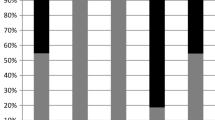Abstract
Sediment from Killarney Lake, Idaho was added to the diet of captive northern bobwhites (Colinus virginianus) to determine absorption of Pb from contaminated sediment. The sediment, containing 4,500 μg g−1 Pb dry weight (d.w.), was added to ground poultry ration at 8% dry matter intake (DMI) for 21 days. Concentrations of Pb in blood, liver, and kidneys of each bobwhite were determined and compared to concentrations in untreated control bobwhites. Treated bobwhites showed no significant decline (P>0.05) in food intake or body mass over time. In 90% of treated bobwhites, blood Pb concentrations reached levels associated with clinical Pb poisoning (>0.8 μg g−1 wet weight, w.w.); and all treated bob-whites had elevated liver and kidney Pb concentrations. It was shown that tissue Pb accumulation can occur from ingestion of Pb-contaminated sediment.
Similar content being viewed by others
References
Analytical Software (1991) Version 3.5, Analytical Software, St. Paul, MN
Arthur WJ, Alldredge AW (1979) Soil ingestion by mule deer in northcentral Colorado. J Range Manage 32:67–71
Arthur WJ, Gates RJ (1988) Trace element intake via soil ingestion in pronghorns and in black-tailed jackrabbits. J Range Manage 41:162–166
Benson WW, Brock DW, Gabica J, Loomis M (1976) Swan mortality due to certain heavy metals in the Mission Lake Area, Idaho. Bull Environ Contam Toxicol 15:171–174
Blus LJ, Henny CJ, Hoffman DJ, Grove RA (1991) Lead toxicosis in tundra swans near a mining and smelting complex in northern Idaho. Arch Environ Contam Toxicol 21:549–555
Chupp NR, Dalke PD (1964) Waterfowl mortality in the Coeur d'Alene River Valley, Idaho. J Wildl Manage 28:692–702
Connor EE (1993) Soil ingestion and lead concentration in wildlife species. M.S. Thesis. Virginia Polytechnic Institute and State University, Blacksburg, VA
Dieter MP, Finley MT (1979) δ-Aminolevulinic acid dehydratase enzyme activity in blood, brain, and liver of lead-dosed ducks, Environ Res 19:127–135
Field AC, Purves D (1964) The intake of soil by the grazing sheep. Proc Nutr Soc 23:xxiv-xxv
Fries GF, Marrow GS, Snow PA (1982) Soil ingestion by swine as a route of contaminant exposure. Environ Toxicol Chem 1:201–204
Healy WB (1967) Ingestion of soil by sheep. Proc New Zealand Soc Anim Prod 27:109–120
Kirby DR, Stuth JW (1980) Soil ingestion rates of steers following brush management in central Texas. J Range Manage 33:207–209
Krieger RI (1990) Toxicity and bioavailability studies of lead and other elements in the Lower Coeur d'Alene River. Idaho BLM Tech Bull 90–3, Boise, ID
Mayland HF, Florence AR, Rosenau RC, Lazar VA, Turner HA (1975) Soil ingestion by cattle on semiarid range as reflected by titanium analysis of feces. J Range Manage 28:448–452
Pain DJ (1989) Haematological parameters as predictors of blood lead and indicators of lead poisoning in the black duck (Anas rubripes). Environ Pollut 60:67–81
Reeder WG (1951) Stomach analysis of a group of shorebirds. Condor 53:43–45
Sandell EB (1950) Colorimetric determinations of trace metals. Wiley-Interscience, NY
Sanderson GC, Bellrose FC (1986) A review of the problem of lead poisoning in waterfowl. Illinois Natural History Survey Special Publication 4, Champaign, IL
SAS Institute Inc (1987) Release 6.04 Edition. SAS Institute Inc, Cary, NC
Scanlon PF (1982) Wet and dry weight relationships of mallard (Anas platyrhynchos) tissues. Bull Environ Contam Toxicol 29:615–617
Scanlon PF, Stotts VD, Oderwald RG, Dietrick TJ, Kendall RJ (1980) Lead concentrations in livers of Maryland waterfowl with and without ingested lead shot present in gizzards. Bull Environ Contam Toxicol 25:855–860
Scheuhammer AM (1989) Monitoring wild bird populations for lead exposure. J Wildl Manage 53:759–765
Author information
Authors and Affiliations
Rights and permissions
About this article
Cite this article
Connor, E.E., Scanlon, P.F. & Kirkpatrick, R.L. Bioavailability of lead from contaminated sediment in northern bobwhites, Colinus virginianus . Arch. Environ. Contam. Toxicol. 27, 60–63 (1994). https://doi.org/10.1007/BF00203889
Received:
Revised:
Issue Date:
DOI: https://doi.org/10.1007/BF00203889




